Wegmans didn't come. So here's how Buffalo's East Side is building its own food economy
Spinal surgery gives a man time to think. And on Buffalo's East Side in 2016, Alexander Wright had a pressing question on his mind.
Why is my community still like this?
From age 19, Wright had devoted himself to nonprofit after nonprofit, trying to help raise up his community. But in starkly segregated Buffalo, decades of disinvestment and white flight had left behind a hollowed East Side landscape of vacant lots and boarded-up buildings.
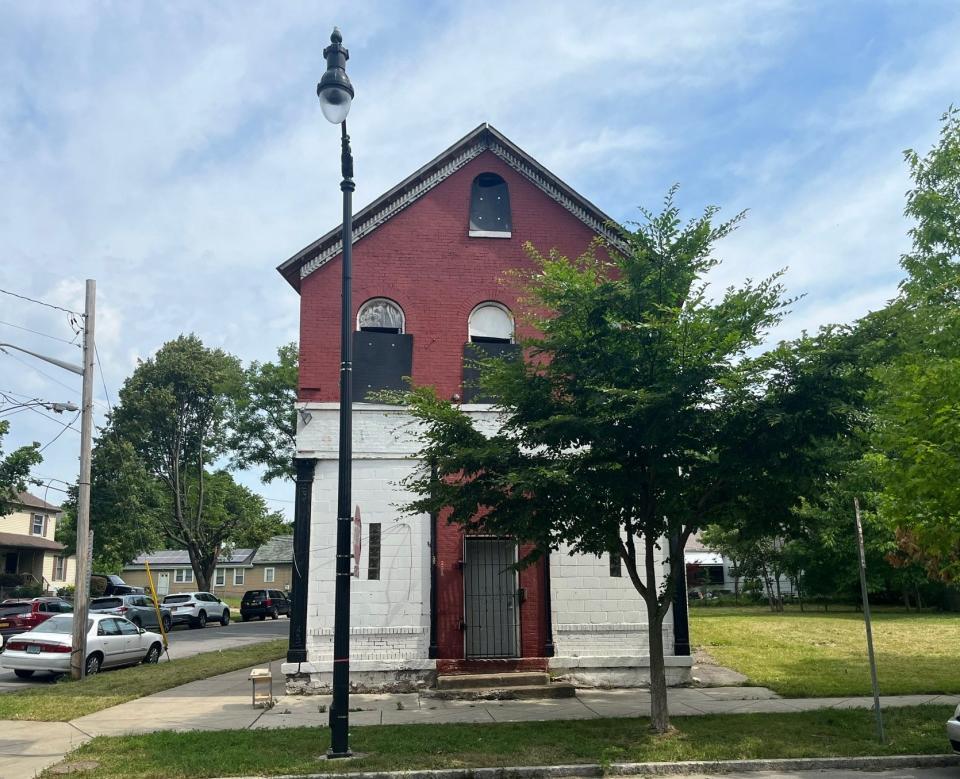
Supermarkets with fresh produce had all but abandoned his side of the city, home to nearly 85% of Buffalo’s Black population. Some chains, like Rochester-based Wegmans, never arrived in the first place. For Wright, handing out boxes at a food pantry began to feel like offering Band-aids for a tactical nuke.
So Wright thought on it. And he did research. And he thought some more. Still awaiting risky surgery for a congenital spine condition, he strolled his baby son down to community meetings, talking to anyone who’d listen.
“I’m in a neck brace, pushing my little dude around,” he remembered. “And I’m saying, ‘Hey … hey … we need to have a food co-op.’”
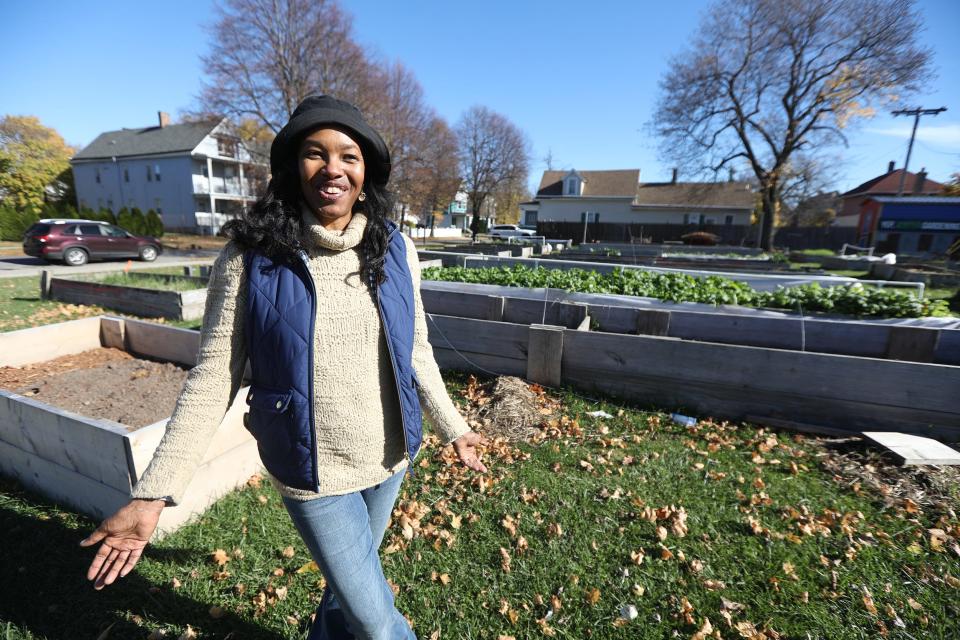
Six years after that humble start, the African Heritage Food Co-op now sells its produce at mobile markets across the East Side and from a rented storefront in Niagara Falls. By next summer, Wright hopes the co-op will boast a space of its own in the East Side’s historic Fruit Belt neighborhood.
The store’s slogan: “Anything less than ownership is unacceptable.”
But the co-op isn’t alone. African Heritage is part of a grassroots movement to rebuild the East Side's food supply chain from the topsoil up, without relying on the chain supermarkets that sell food to much of the nation — but which have shown little interest in urban neighborhoods like Buffalo's East Side.
On formerly vacant city plots in Buffalo’s Masten Park neighborhood, urban farmer Allison DeHonney is growing tomatoes and ground cherries and lush hydroponic collards to sell at mobile markets and to local health centers — as well as to the co-op.
A mile farther east, health advocate Rita Hubbard-Robinson is soliciting funding for a market and hydroponic farm at an defunct auto parts plant.
“The beautiful thing is we’re working together,” Wright said. “What we’re creating individually is connected. If we get the proper support in the next three years, East Buffalo is not going to look the same.”
A mass shooting at Tops brings attention to food apartheid in Buffalo
The scarcity of healthy food on Buffalo’s East Side is hardly new, nor are grassroots efforts to solve it. But it took an unspeakable horror to make anyone outside his neighborhood pay attention, Wright said.
In May, a white supremacist gunman from rural New York drove to the Tops supermarket in the East Side's Masten Park neighborhood and shot 13 people, killing 10 Black residents and traumatizing countless more. The shooting set off citywide outpourings of anger and grief. It also focused nationwide attention on a situation that seemed inconceivable.
The mass murderer, who pleaded guilty in November to charges of domestic terrorism, had found his target by researching racial demographics, according to Buffalo police commissioner Joseph Gramaglia. And the Tops on Jefferson Avenue was the lone full-service supermarket for miles on the East Side, not just a food store but a de facto community center and gathering place for its Black community — a store residents lobbied for long and hard before it finally opened in 2003.
"The reason that racist coward came here is because you had one store where you could kill Black people,” Buffalo resident James Wright told the Rochester Democrat and Chronicle in July. “You still only have one store where you can kill Black people.”
When Tops closed for two months after the shooting, the number of supermarkets in the area dropped to zero. Buffalo’s residents responded with emergency solutions: a small village of outreach tents, food tables and fast-food trucks parked next to impromptu memorials to the 10 victims.
Tops and the city of Buffalo funded buses to other supermarkets. Though Wegmans long resisted activists’ calls to open an East Side location, it donated $400,000 to a victims fund and offered free delivery to East Side residents. Food banks joined Wright and DeHonney in handing out produce. A free burger truck from McDonald’s inspired hours-long lines.
But emergency charity can’t solve the underlying problem, said urban planning professor Samina Raja, who founded the University of Buffalo’s Food Lab to study how cities succeed and fail at building food infrastructure.
“I think that policymakers’ responses are reactionary. And unfortunately, that's what keeps us spinning our wheels," she said. “Every time I hear about more money being sent out to deliver food, my question is, what proportion of those dollars could be used to help Alex get his store up and running?”
The private market has spectacularly failed Black communities like Buffalo's East Side, she said. In a 2008 study, she found that Black neighborhoods in the region were choc-a-bloc with corner stores offering high-price, low-quality goods.
“Usually junk food, like chips, sugary drinks, candy, honeybuns. Really highly processed, high sodium foods,” said Jaime Swygert, who runs an annual agricultural pavilion at Buffalo’s Juneteenth festival. “If there were any fruits and vegetables available, they would be overrun, old, not appealing looking and also at a very high cost.”
When it came to stores selling fresh produce and healthy food, residents of Black communities had just 40% as much access as white ones, Raja’s study showed — even after controlling for income.
Tops reopens:As Buffalo grocery store quietly reopens after shooting, residents gather with mixed emotions
Indeed, the map of supermarkets mirrored the map of historically redlined areas dating back as far as 1931, a racially determined map of where banks chose not to invest.
Raja does not refer to Buffalo's East Side as a food desert. Deserts occur naturally. This was a series of human decisions.
“I use the term ‘food apartheid,’” she said.
This summer, Raja’s team ran the East Side grocery numbers again.
“Unfortunately … things have worsened,” she said. “They haven't gotten better.”
Wegmans and other grocery chains long absent on Buffalo's East Side
For many in Buffalo, Wegmans has become a totem of that injustice.
The popular Western New York grocery chain — which routinely wins awards as a good corporate citizen, and the best grocery store in the region — has opened eight locations in Buffalo’s predominantly white, more affluent suburbs.
But it’s opened only one within city limits, and none on the East Side. None of Wegmans’ Western New York stores are located in ZIP codes with a Black population higher than 25%, according to an analysis by USA Today Network. By comparison, about a tenth of competing Aldi and Tops supermarkets are located in Black neighborhoods.
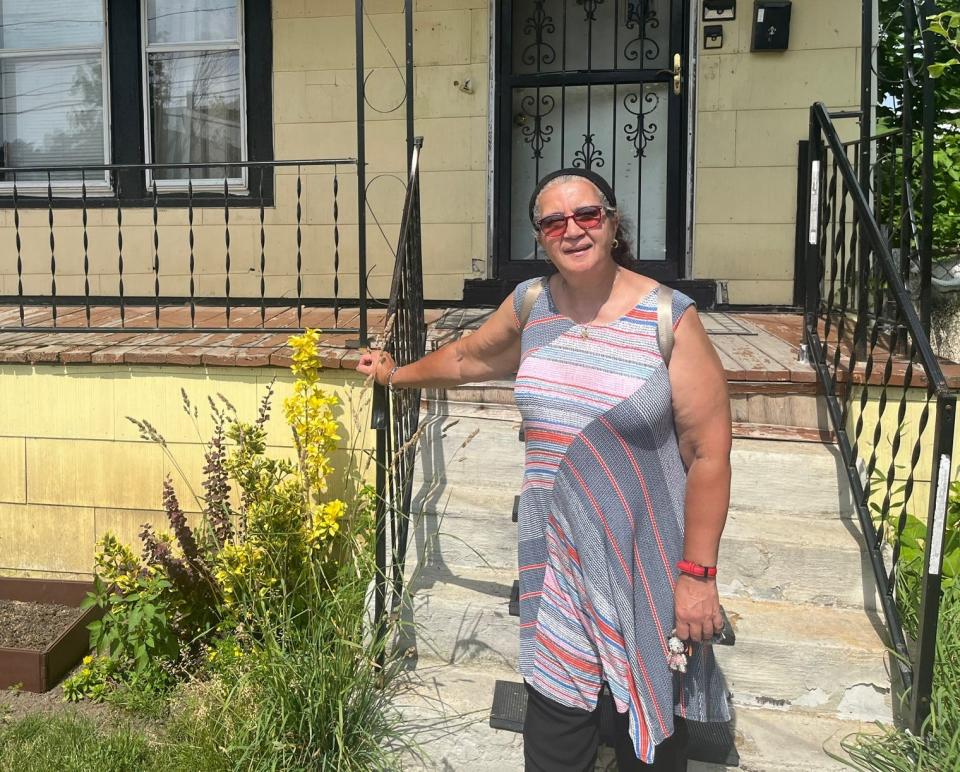
In Buffalo’s historically Black Fruit Belt, activist Dennice Barr refuses to even say Wegmans’ name.
She calls it, simply, “that store that has decided not to serve our community.”
Wegmans said it locates its stores where they're likely to succeed.
“We don’t specifically shy away from cities,” a Wegmans spokesperson responded when asked why they don’t locate stores in urban neighborhoods affected by food inequity. “However, in order to pursue an urban location, it must meet our standard criteria.”
In recent decades, this has meant high-volume, large-footprint stores in densely populated regional hubs with growing populations. In the meantime, Wegmans has closed older, smaller urban stores — including those in predominantly Black neighborhoods in the chain’s hometown of Rochester.
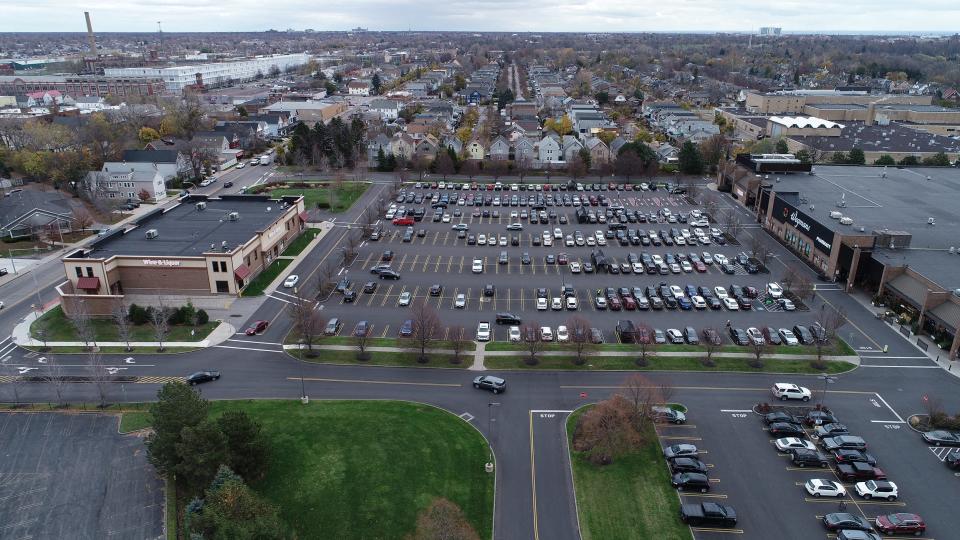
Wegmans uses sophisticated market research to chase a specific type of customer, said grocery expert Phil Lempert, a frequent television commentator better known as the Supermarket Guru. The Wegmans customer is the sort of person who buys high-margin prepared foods, follows food trends and wants to choose among a hundred varieties of olive oil.
“That model isn’t going to work everywhere,” Lempert said. After all, stocking all that olive oil is expensive.
But the problem is not that stores can’t succeed in working-class city neighborhoods, said grocery store consultant Burt Flickinger III, whose family founded the IGA chain of grocery stores.
He cites the prior success of grocery chains such as A & P in urban areas — smaller stores that were responsive to their customers, and worked to integrate themselves into their neighborhoods with post offices and police substations.
That success was undone by a debt-fueled buying spree from private equity companies, Flickinger said, leading to the disastrous consolidation of the grocery industry that began in the 1980s.
“The prominent and profitable inner city chains have been looted,” he said. In Buffalo, Wegmans and most other chains have not shown interest in picking up the slack.
As far as Raja is concerned, focusing on Wegmans misses the point. “What about Whole Foods?” she said. “What about Trader Joe’s?”
Some neighborhoods “hoard” all the supermarkets in the region, she said, noting that the first-ring Buffalo suburb of Amherst has four major supermarkets within a square mile of each other. Other neighborhoods go without.
Asking for-profit companies to solve broader structural problems of low density and demolitions and disinvestment will probably not be successful, said housing activist and former mayoral candidate India Walton.
“Businesses exist to make money,” Walton said. “If Wegmans doesn't feel like they're going to be profitable in a certain geographic area, I can't really blame them.”
The goal, she said, is not to beg Wegmans to come to the East Side. It’s to help turn the East Side into a place where Wegmans wants to be.
Rebuilding the food chain in Buffalo with urban farming
In a grow shed painted the colors of the Buffalo Bills, farm manager Rickey Fleming stood beneath a lush canopy of hydroponic collards and proudly pointed to an upstart of a leaf that may be the first of its kind.
“This right here?” he said. “That is the world’s first Buffalo-grown indoor watermelon.”
Or at least, it might be eventually. As of October, the actual melon is still hypothetical.
On two once-vacant city plots just a half-mile from the Tops store on Jefferson, that watermelon is part of a much bolder and more consequential experiment.
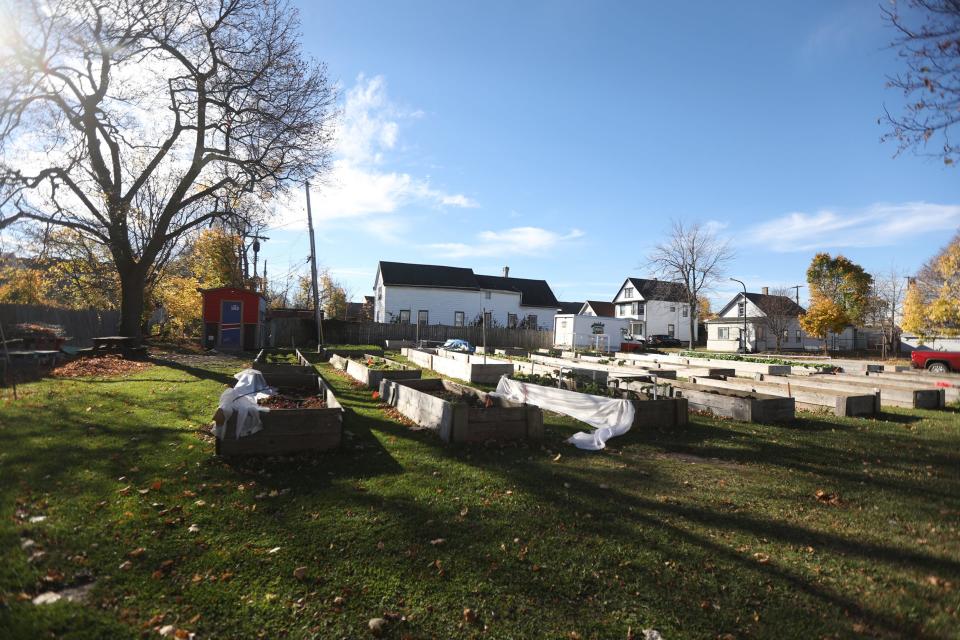
Urban Fruits and Veggies, alongside its nonprofit arm Buffalo Go Green, is a working farm on the city’s East Side — home to a 72-foot greenhouse lushly planted with year-round tomatoes, vertical rows of greens and radishes in a grow shed donated through the Bills Foundation, and 33 outdoor raised beds in the process of being tilled over for winter.
There, Fleming and the farm’s founder, Allison DeHonney, are planting the seeds for an expansive urban farming enterprise that already serves up its city-grown produce to 25,000 families annually. The farm sells its crops through its own mobile markets, at the African Heritage co-op, and through a vegetable “prescription program” delivered to families through the nonprofit Community Health Centers of Buffalo.
Often, this involves educating customers about new kinds of fruit that grow well in the city. In one of the farm’s beds, DeHonney lifts up wispy leaves to pluck a wee husked fruit from the soil, a ground cherry that both tastes and looks like a mix between a grape and a cherry tomato.
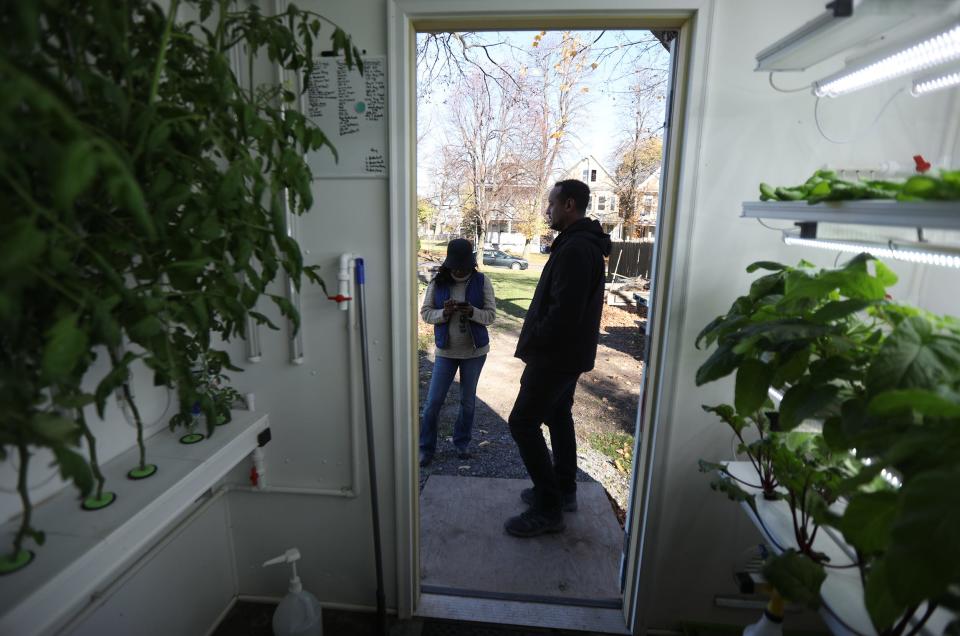
“At the markets I just hand these to people,” Fleming said, laughing. “‘Here, take this.’ That’s the only way they’ll try it: Give it to them and make them eat it. And then they love it.”
Urban Fruits will soon grow to include five more greenhouses down the road at a new site called Bailey Green, not to mention an indoor-farmed freight container parked on the ground floor of a onetime grain elevator complex along the Buffalo River.
Each shipping container can foster 90,000 pounds of food a year, DeHonney said. The indoor crops, stacked up in vertical rows along the sides of the container, are fed by a piped-in nutrient solution under LED lights.
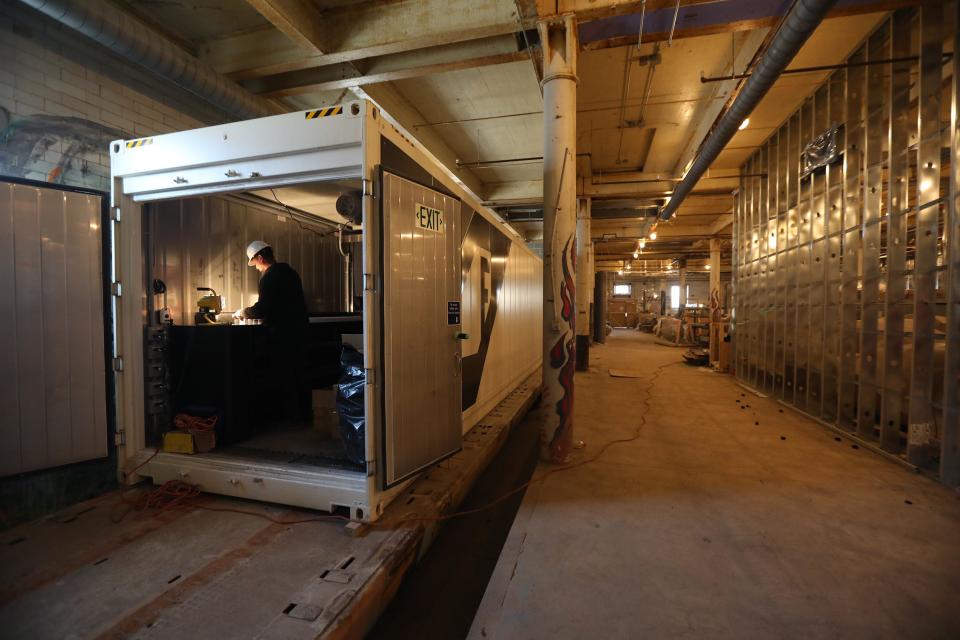
Gaining access to city-owned plots to farm, and getting permission to purchase them, has been a long and bureaucratic process, even with sympathetic city council members. But with newfound attention to food supply chain issues during the COVID-19 pandemic, and after the tragedy at Tops, DeHonney has been making her pitch for funding to more receptive ears.
After the massacre left Jefferson Avenue without a supermarket, Wright hoped lawmakers would also finally see the need for the food co-op he’d been trying to build in the Fruit Belt for five years, in a historic building at 238 Carlton St.
After each new crisis in Buffalo, he’d spent years watching lawmakers shower millions on developers to plop down buildings that left the surrounding community unchanged, he said. And so this time, he hired a lobbyist.
“I said, we need to be in front of the right people who control these dollars,” Wright remembered.
Hochul’s team came down to visit one of Wright’s fruit stands. And lo and behold, amid a $50 million aid package to Buffalo announced in June — mostly direct aid to homeowners and small businesses — there was a fateful line item. About $3 million would help build and support the African Heritage Food Co-op.
“I gotta give credit to the governor's office,” he said. “They came down and spoke to the community.”
Multi-pronged efforts to build an entire food system
But of course no one farm, and no one market, can solve a broken supply chain on Buffalo’s East Side, Raja said.
To make any effort sustainable, she said, the city needs a critical mass at every level of food infrastructure: not just farms and stores but food distributors and processors. Since 2019, an organization called the Buffalo Food Equity Network, founded by advocate Rebekah Williams, has been trying to put together a model for what this could look like.
In response to the acute crisis of the pandemic, Williams and Raja began a weekly Zoom meeting among 160 community leaders — connecting a disparate group of farmers, health advocates, activists and entrepreneurs. That effort continued with a workshop last October designed to connect each point on the supply chain to show how a self-sufficient food distribution network could function.
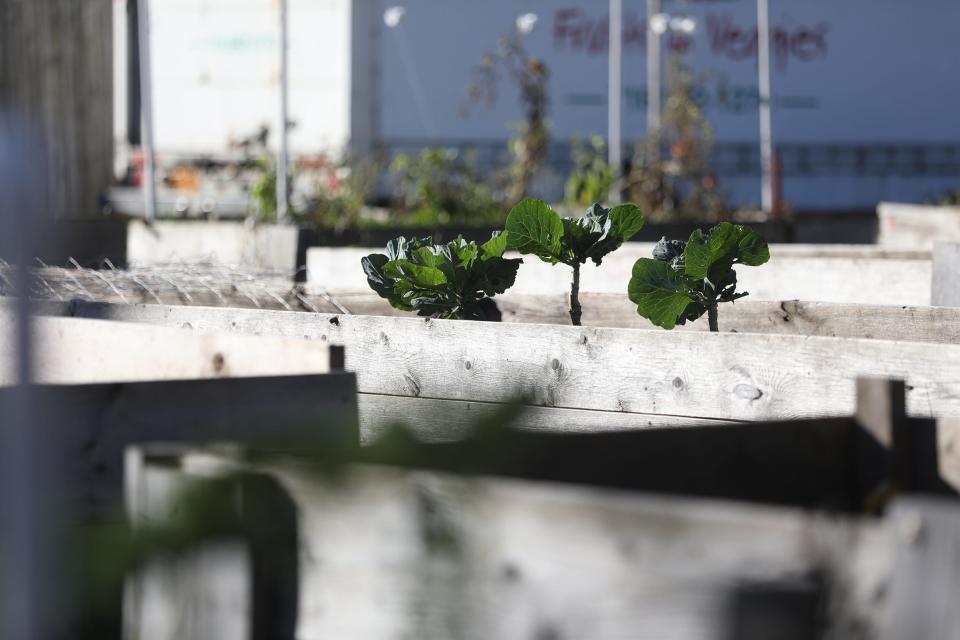
“From the farmer, to the trucks, to the people getting food ready at tables, to people in the community going door to door,” Williams said. “Getting all those pieces together is an effort in itself.”
At a food equity conference held in Buffalo this fall, Wright, DeHonney and others made their cases directly to banks and government leaders that a self-sufficient East Side Buffalo was in reach.
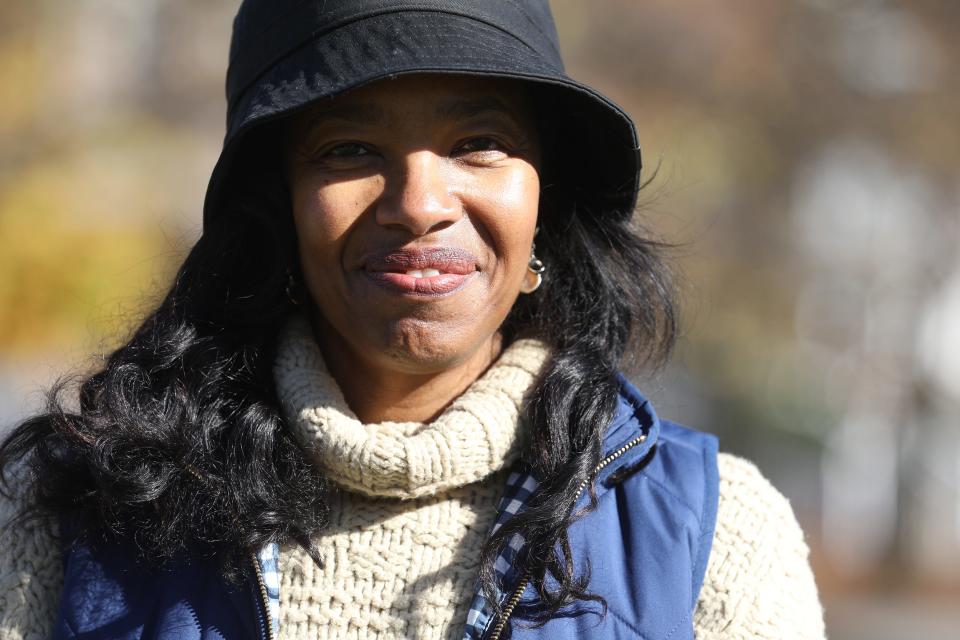
Health advocate Rita Hubbard-Robinson outlined a plan she’d been working on for more than a decade: Project Rainfall, a hydroponic farm and farmers market in Buffalo’s vacancy-riddled Grider neighborhood. It would be housed at the onetime home of auto parts maker Houde Engineering.
Once it’s built, said Hubbard-Robinson, the project would be self-sufficient. A large local restaurant has pledged to buy microgreens grown on the site as a cash crop that would support other ventures like health education, and a market that could sell produce from other farmers.
But like Wright and DeHonney, she is still putting together the gap funding to make her plan a reality, after the pandemic halted work on the project — which sits half deconstructed and covered in optimistic muralwork depicting a quilt formed of people.
Funding Project Rainfall, as well as a food processing plant devised in collaboration between Wright and DeHonney, and a holistic agriculture center planned by DeHonney alongside her ongoing farm projects, would come to $20 million, Hubbard-Robinson said.
“That’s a lot of money for me,” she said. “But in the grand scheme of things, it’s not a lot of money compared to the hundreds of millions that have gone to development (in Buffalo). ... When you look at the problem, you say, ‘Oh, my God, the problem is enormous.’ But a big answer to an enormous problem is still small, comparatively speaking.”
The net effect of these projects is greater than just food, Wright said. It’s improving health outcomes. It’s building an entire economy that had been decimated over years of neglect.
“It’s jobs, and employment with a strong living wage,” he said. “It’s providing technical assistance so that they can build capacity to be the economic agents in their own communities. And that's how the community changes.”
A chain supermarket could simply pull up stakes at any time, he said. Even successful local stores often die when their owners do. The point of co-ops and nonprofits, he said, is that they’re owned by the community, and can outlast any one founder.
“We want to make it so that we don't need a Wegmans,” Wright said. “Because the people who live in the community will have built their own Wegmans.”
WEGMANS AND THE WORLD
The USA TODAY Network is exploring how Wegmans is adapting to our changing world. We'll learn insights from Wegmans workers, sit in on a rare interview with top Wegmans leadership, dive deep into the chain's location decisions, visit one of the newest and most unlikely grocery store spots, find out how prepared foods get a second act, and learn the story behind the stores' iconic tote bags. Along the way, we'll reveal how Wegmans' business practices affect our communities, its workers and the environment.
This article originally appeared on USA TODAY NETWORK: Wegmans has no locations on Buffalo's East side, site of Tops shooting

